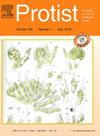Significance of the Nudiform and Tectiform Modes of Silica Deposition, Lorica Assembly and Cell Division in Choanoflagellates as Exemplified by Stephanoeca diplocostata and Enibas spp.
IF 2.1
3区 生物学
Q4 MICROBIOLOGY
引用次数: 2
Abstract
The deposition of silicified costal strips and lorica assembly in choanoflagellates is precisely linked to the cell cycle. A minority of species undergo nudiform division whereby a loricate cell divides to produce a naked daughter cell that deposits a set of costal strips and then assembles a lorica. Most species undergo tectiform division whereby a parent loricate cell produces a set of costal strips, divides and passes on the stored strips to a daughter cell that immediately assembles a lorica. Many phylogenetic analyses recover nudiform and tectiform species as sister-clades giving the impression that they are distinct evolutionary lineages. However, the tectiform species Stephanoeca diplocostata is capable of undergoing nudiform division and depositing costal strips and assembling a lorica with certain modifications in a nudiform manner. The recent discovery of a new genus, Enibas, comprising species with Stephanoeca-like loricae that undergo nudiform cell division and on phylogenetic analysis occur as a sister group to other nudiform species has drawn attention to whether there are also unique features in lorica construction. A range of Enibas loricae is illustrated and it appears that there are unique features which might be interpreted as being derived from a Stephanoeca-like ancestor.以Stephanoeca diplocostata和enspp为例的毛鞭毛虫裸形和隐形二氧化硅沉积、Lorica组装和细胞分裂模式的意义
甲藻中硅化肋带的沉积和懒虫的组装与细胞周期密切相关。少数物种经历裸体分裂,懒猴细胞分裂产生一个裸体的子细胞,该子细胞沉积一组肋带,然后组装懒猴。大多数物种都会经历保护态分裂,通过这种分裂,亲本懒猴细胞会产生一组肋带,分裂并将储存的肋带传递给子细胞,子细胞会立即组装懒猴。许多系统发育分析将裸形和保护形物种恢复为姐妹分支,给人的印象是它们是不同的进化谱系。然而,保护型物种Stephanoeca diplocosta能够进行裸体分裂,沉积肋带,并以裸体方式组装经过某些修饰的懒猴。最近发现了一个新属Enibas,该属由具有类似Stephanoeca的loricae的物种组成,这些物种经历了裸体细胞分裂,并在系统发育分析中作为其他裸体物种的姐妹群出现,这引起了人们对lorica构建是否也有独特特征的关注。图中展示了一系列的埃尼巴斯loricae,似乎有一些独特的特征可以被解释为源自类似Stephanoeca的祖先。
本文章由计算机程序翻译,如有差异,请以英文原文为准。
求助全文
约1分钟内获得全文
求助全文
来源期刊

Protist
生物-微生物学
CiteScore
3.60
自引率
4.00%
发文量
43
审稿时长
18.7 weeks
期刊介绍:
Protist is the international forum for reporting substantial and novel findings in any area of research on protists. The criteria for acceptance of manuscripts are scientific excellence, significance, and interest for a broad readership. Suitable subject areas include: molecular, cell and developmental biology, biochemistry, systematics and phylogeny, and ecology of protists. Both autotrophic and heterotrophic protists as well as parasites are covered. The journal publishes original papers, short historical perspectives and includes a news and views section.
 求助内容:
求助内容: 应助结果提醒方式:
应助结果提醒方式:


